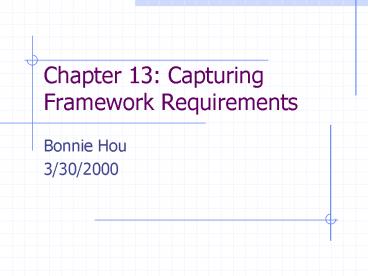Chapter 13: Capturing Framework Requirements - PowerPoint PPT Presentation
1 / 14
Title:
Chapter 13: Capturing Framework Requirements
Description:
Bonnie Hou. 3. Background. Experiences in a broad spectrum of domains by authors ... Bonnie Hou. 14. Summary. Isomorphism of 3 Lvls of UC and FW ... – PowerPoint PPT presentation
Number of Views:46
Avg rating:3.0/5.0
Title: Chapter 13: Capturing Framework Requirements
1
Chapter 13 Capturing Framework Requirements
- Bonnie Hou
- 3/30/2000
2
Road Show
- Background
- Framework Requirements
- Requirement Lvl
- Use-case Assortment
- Create a Business Case
- Large Use-Case Model
- Related Works
- Summary
- (abbr. FW-Framework, UC-Use Case)
3
Background
- Experiences in a broad spectrum of domains by
authors - Formal method developed over yrs of experiences
- Domain analysis domain knowledge and think
abstractly - UC modeling
- Solid process
4
FW Requirements
- FW Development two approaches
- Refactoring Approach
- Priori Approach
- Reenskaugs 4 generalized FW conditions
- There must be multiple elements with common
characteristics - Requirement for FW must be well understood
- Sufficient business justification must exist for
FW - Pattern must be abstracted
5
FW Requirements- Requirement Lvl
- Hierarchical classification of requirements
- Business / Application / Design
- Corresponding Lvl of Requirements, UC and FW (?)
6
FW Requirements UC Assortment
- A technique supporting the capture of domain
info. during UC modeling, which is then used for
FW development in priori approach. - A step btwn requirement analysis and analysis
modeling. - (contd)
7
FW Requirements UC Assortment (cond)
- Technique Abstraction (Pattern figured out)
- Heuristics
- 1. UCs that represent common behavior, but that
do not share a primary actor, maybe grouped by
creating an abstract actor - 2. Each ensemble UC must follow all of the
behavior defined in the FW UC, although the
ensemble UC may determine how it will follow that
behavior - (cond)
8
FW Requirements UC Assortment (cond)
- Heuristics
- 3. When two UCs have an extends relationship with
the same higher-lvl UC, their primary actors
should be specializations of the abstract primary
actor associated with the higher-lvl UC - 4. UCs that describe action on a common domain
object should be grouped under a common actor. - (cond)
9
FW Requirements UC Assortment (cond)
- Examples UC Modeling and
10
FW Requirements UC Assortment (cond)
- UC Assortment
- Find abstract actors
- Identify abstract UC through grouping
- Describe abstract UC
- (depending on domain knowledge and abstract
thinking / help of heuristics) - More successful as size grows
11
FW Requirements Create a Business Case
- Make to justify amount of effort/money
- Could be made on variety of lvls
- Easier with well defined UC model
- Helpful in risk control, but not necessary
- A field for future research
12
FW Requirement- Large UC Model
- Increase in functionality and size could provide
more opportunities to factor out commonality - Change cases included to capture near-future
changes - Attention Use Case Explosion
- Too much details
- Too much change cases
- (Thought there is always tradeoff.)
13
Related Works
- Gause and Weinberg
- grouping requirement attributes
- Taligent
- view domain expertise as the focus
- Jacobson, Griss and Jonsson
- utilize use case to identify component systems
using feedback fm application engineers - Koskimies and Mossenbock
- two-phases (generalization of problem and
implementation)
14
Summary
- Isomorphism of 3 Lvls of UC and FW
- UC assortment to capture FW requirements in a
priori approach
Building Application Framework, pp320































